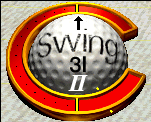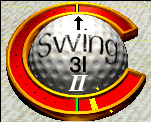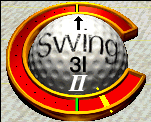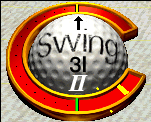 Sand Play
Sand Play Sand Play
Sand PlayAim: To familiarise you with a series of stock shots to cope with bunkers, and to give you an understanding of how to maximise your percentages in getting out of the sand and close to your target...
Early notes:
I'm not really too good in the sand, and am hoping for more help
on this issue, but for what its worth, this is what I do. I
always use the snap point at 5 o'clock whether it's a fairway or
greenside bunker. In a greenside bunker I use a chipping wedge
and play the shot as I would a chip from the fringe, remembering
that in a bunker you nearly always have an uphill lie, which
equates to some extra loft in the shot. Once I've picked my
distance ( see chipping ) I will aim for that, and use the new
snap point to adjust the length, if I think Ive gone a bit too
far I will snap before I get to the new point, but more often
than not, I always let it go slightly past the new snap point so
the shot comes out a bit hotter than intended, it still seems to
stop pretty quickly and I find its better to get it out long than
to go short. Remember also, the snap out of sand doesnt affect
the aim, so if the green is flat near the pin you can hole a lot
of bunker shots, even more than normal chips. In fairway bunkers
I always find the ball comes out short, so I take one or two
clubs extra and try for the new snap point, sometimes I will go 3
or 4 clubs up and increase the loft, but my main concern is to
get out in one piece somewhere towards the green. Like I say, I
havent really got to grips with LS99 sand yet, mainly because I
avoid going in it ! ( a great sand tip ! ), but maybe that will
help someone...
Further Notes: An amazing tip is to
stay out of the sand (thanks for that bomber,yeah,yeah)....so use
your practice rounds to find out which bunkers are typically in
your way ( at driving distance or guarding flags) and change your
game/mindset to avoid them. In mid-game, use your aiming pin to
probe bunkers, especially near greens, you can then look at the
profile information to see if its a deep black hole, or theres a
bank in front of it. These really should be avoided at all costs,
so again, play way away from these, even if it means being
further from the pin than you'd like.You can make a multiple
bogey in a heartbeat in the deep ones, try some of those at
St.Andrews to see what I mean (like the "Sands of
Nakajima" at the 17th in front of the green)
Main Sand Chart (my clubs)...distances for the main snap points
| Club | 6 o'clock | Halfway between 5 and 6 (approx) |
5 o'clock (the new sand snap) |
Halfway to end of meter (approx) |
%age of dist. at 5 o'clock |
| yards |  |
 |
 |
 |
|
| 2W | 41-77 | ||||
| 3W | 41-75 | ||||
| 4W | 41-72 | ||||
| 5W | 42-68 | 132-152 | 193-208 | 86-131 | 92% |
| 3i | 32-58 | 115-136 | 174-188 | 59-106 | 90% |
| 4i | 32-56 | ||||
| 5i | 31-51 | ||||
| 6i | 31-45 | 95-107 | 141-149 | 79-114 | 88% |
| 7i | |||||
| 8i | 29-40 | ||||
| 9i | 26-37 | 75-82 | 111-116 | 80-105 | 90% |
| PW | 27-35 | 72-77 | 104-108 | 106-117 | 94% |
| SW | |||||
| LW | 19-23 | 48-51 | 69-71 | 103-110 | 89% |
Sand Chart For Normal Shots + Loft ( ie these are NOT chips)..snap here is at 6 o'clock
| Pips | Default | +2 loft | +4 loft | Pips | Default | +2 loft | +4 loft | ||
| feet | feet | ||||||||
| 16 | 57-69 | 48-54 | 39-46 | 16 | 81-105 | 75-96 | 69-84 | ||
| 12 | 30-38 | 25-32 | 20-24 | 12 | 45-60 | 42-57 | 38-53 | ||
| 8* | 11-14 | 8 | |||||||
| LW | 6-snap | PW | 6-snap | ||||||
| normal | shot | not | chip | normal | shot | not | chip |
Sand Chipping Charts (these ARE chips) hit at the sand-snap point at 5 o'clock
| Lofted | LW | Chip | 5-snap | ||||
| feet | |||||||
| Pips | default | +4 loft | +8 loft | ||||
| 16 | 42-59 | 33-48 | 23-32 | ||||
| 12 | 24-40 | 18-23 | 13-15+ | ||||
| Pitching | PW | Chip | 5-snap | ||||
| feet | |||||||
| Pips | default | +5 loft | +11 loft | ||||
| 16 | 57-92 | 51-77 | 38-56 | ||||
| 12 | 29-60 | 26-49 | 20-33 |
Chart to show the effect of missing the sand-snap on a chip-shot
| 5:30 | 5:00 | 4:30 | 4:00 | Chips only.... | |||
| PW | |||||||
| 16 pips | 32-56 | 55-78 | 36-80 | 13-80 | |||
| 12 pips | 16-32 | 27-53 | 17-53 | 12-52 | |||
| LW | |||||||
| 16 pips | 24-39 | 43-57 | 44-72 | 27-80+ | |||
| 12 pips | 13-18 | 23-38 | 24-51 | 19-52 |
Well, there's a hell of a lot of data included here, so I'll try to go through each table step by step and give my conclusions/advice in general terms, because as you know the last thing I want you to do is try to remember everything, much better to learn general rules and principles and then apply your creativity to a shot
1) The
main Sand Chart
These were obviously hit out of a fairway bunker
with no lie problems. First of all, when you are in a bunker and
you're hundred(s) of yards from your target, you are going to
have to try and hit this new sand-snap point. You'll see that
when you are in sand, your meter is the same as before but with
two little dots (why they couldnt draw a line I dont know!) at
about 5 o'clock. This is your "pick-point", and by
hitting this you are cleanly hitting the ball off the top of the
sand, in a manner which hopefully will resemble Sandy Lyle's
marvellous effort at the 18th of Augusta in the 1988 Masters
(hoorah!). By leaving the snap until after that you are hitting
the ball lower and harder, so you may well hit it further but you
could also scuff the ball into the lip of the bunker. If you hit
short of the new snap you are digging more sand with the shot and
the distance is less. Cruel, isn't it how Access have created
this so your carefully nurtured snap is now of no use, and you
have to force yourself to leave the snap until 5 o'clock when the
meter is really speeding...grrrrrrrrrrrrr..I'll also add that I'm
not sure if it's possible to get a clean snap, so if you look at
the diagrams above the snap line you leave is quite thick, not
like the thin,clean line you get at 6 o'clock. If this is just me
being crap, let me know and send a screenshot showing a nice
clean line at 5 o'clock!
OK, first thing to notice is that even if you hit the sand snap
correctly, you are only going to get about 90% of the distance of
the club (variations due to slight variations in snap
position...I hit as close to the right point as I could), so you
should take more club, bearing in mind that by going up a club or
two you are hitting the ball lower so you are more likely to hit
the lip, but generally I take 1 or 2 more clubs depending on the
approach shot and pin position.That's all there is to say about
long fairway bunker shots, except if you fall in a pothole at
St.Andrews dont come crying to me for help, I don't bloody know
how to get out of those chuffs.Could be time for a sideways hack
there in some of them ! You should also be aware that at champ
level, the penalty is higher (as always) for missing the sand
snap, and your club distances are much shorter, the ball just
fizzes out low and ugly or high and choking, so be prepared to
play even safer there...make sure you get out won't you ?haha
Now, if your bunker is within 80 yards of your target and the
approach is quite reasonable, it's my advice (advocated
especially by the likes of ErnieB and McAvoy7...thx guys) that
you try to hit 6 o'clock. Not only is your game geared to that,
but its a much easier target to hit.You'll see that because you
are chunking a big bunch of sand with that, the distances are
low, but provided you have the space to allow for the carry and
roll, you'll get much more joy than trying to hit the sand snap
with some lofted club in your hand.If you miss the snap slightly
from 6, you'll just get an extra few yards or a few less, but at
pro level this shouldnt be too severe.Since the difference from
club to club is quite small i didnt bother looking at the effect
of loft and uphill lies, you'll have to decide yourself how much
extra to factor in to the shot and then take the appropriate
club.
2) The
Loft Chart
Well, what do you know, I did do some loft research
after all ! This chart shows the effect of loft settings ( and
can be applied as equivalent lies) on the two wedges I use for
the main pip positions.Not much to say except it does make quite
a difference,especially for the full 12 o'clock (16 pips) shot.
Again, this is using the 6 o'clock snap point.The distance change
with loft is not too different from their normal case.
3) The
Chipping Chart
This shows the distances for chip shots hit with my
wedges , using the new sand snap point, I only include 12 and 16
pips because I dont think it's a good idea to go less than that
in case you stay in the sand, but you can see that by adding loft
we can cover chips anywhere from about 15 feet upwards. If you
are in the sand but less than 15 feet from the pin, please tell
me what course you are playing !( just go a bit less than 12 pips
then....)By the way, on chip shots the snap does not
affect the line so for a flat green with no break its in the hole
if you get the pace right. You can use your imagination here so
if you dont hit the strength you want, just let the snap go just
past 5 to get the ball out harder, or just before if you want to
slow it down if you went too far on the meter. Again, although
champ level is more severe with this, the meter goes pretty
slowly on chips so you should be able to get the snaps pretty
much where you want them.
4)
Missed Snap Chip Shots
These were taken at a different bunker/green than
the others so no angry letters please telling me the distances
are a bit different. This chart is just so you can have an
appreciation of how much distance loss you will suffer (at PRO)
by missing the sand snap point.What you'll see is that generally
for the pitching wedge, missing late on the sand snap will give
you similar distances but the carry in the air is less, so the
roll is more, this means on downhill greens or hard/fast ones you
will get more distance as the ball flies off, and it can hit the
lip because its going so low, but if you miss early then you will
lose distance dramatically...hence, better to make sure you hit
the sand snap or just after if you are worried about distance or
focus on not letting the snap go past the proper point if you
want to make sure it comes out.Similar for the LW, missing late
causes the shot to land quicker but more roll, so slightly more
distance. Because this club is lofted a lot anyway, it's
definitely a good tip to leave the snap a heartbeat late and the
end result will be very similar to hitting the sand snap
properly, but as you will see the distance does go up quite a bit
relative to the 5 o'clock. For this reason, if you have a 70 odd
foot chip you might want to try a LW chip hit at full pace but
leave the snap until halfway between the sand snap and right at
the end..you'll still get 20 feet of carry but the distance only
varies from 70 to 80 feet for a snap anywhere between 4 and 4.30
on the meter.
Top Tips:
Remember Sand is not my strength, nor is chipping, so be wary of my advice here (especially sand chips!) until you are happy with it (by testing it)
If you need a full club distance, take one or two more clubs and hit the sand snap to get about 90% of the distance of the club
Inside 80 yards use a 6 o'clock snap, more reliable, easier to hit and the whole clubset covers 25-80 yards.
Watch out for uphill lies, these are like added loft, which will affect your distance
Be careful of the lip on high bunkers, consider taking a more lofted club to make sure you get out even if you are short
Be aware that you can adjust the pace of your chip shots by missing the snap either side of the sand-snap